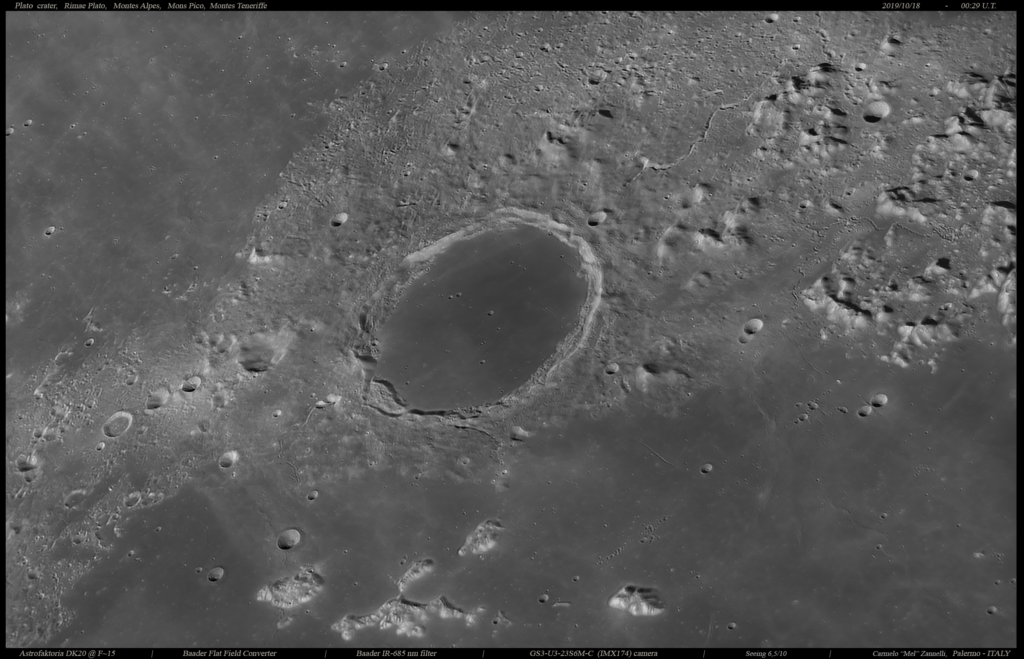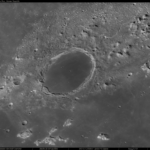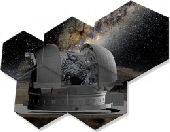Italiano:
Il cratere “Plato” (Platone) è un cratere lunare da impatto riempito di lava con un diametro di 101 km. che si trova sulla costa nord-orientale del Mare Imbrium, all’estremità occidentale della catena montuosa dei Montes Alpes (le Alpi Lunari).
L’età di Plato è di circa 3,84 miliardi di anni, solo leggermente più giovane del Mare Imbrium situato a sud, ed il suo bordo è irregolare con picchi frastagliati alti 2 km che proiettano bellissime ombre prominenti sul fondo del cratere, soprattutto quando il Sole è ad angolo basso (non come in questa mia foto, ripresa in condizioni di alta illuminazione solare).
Nel mare di lava a sud di esso si trovano diverse alture denominate collettivamente “Montes Teneriffe”, visibili qui in basso nell’immagine. A nord di esso si trova l’ampio tratto del “Mare Frigoris” (visibile in alto a sinistra) mentre ad est del cratere, tra le Montes Alpes (in alto a destra dell’immagine), vi sono diversi gruppi di fratture denominate collettivamente “Rimae Plato”. Il bordo di Plato è circolare, ma dalla Terra appare ovale a causa della posizione inclinata con cui esso ci risulta visibile dalla nostra prospettiva.
Grazie per la Vostra attenzione e…… ad maiora semper !
Dettagli tecnici:
Telescopio Astrofaktoria DK20 @ ~ F/19 – Baader FFC Multiplier – Baader IR 685nm filter – GS3-U323S6M-C camera – Seeing 6,5/10 in IR band – sito: Palermo @ my personal Observatory.
***************************************
English:
The “Plato” crater is a lunar impact crater filled with lava with a diameter of 101 km. which is located on the north-eastern coast of the Mare Imbrium, at the western end of the Montes Alpes mountain range (the Lunar Alps).
The age of Plato is about 3.84 billion years, only slightly younger than the Mare Imbrium located to the South, its edge is irregular with jagged peaks 2 km high that project beautiful prominent shadows at the bottom of the crater, especially when the Sun is at a low angle (not like in this photo of mine, taken in high solar lighting conditions).
In the lava mare, south of it, there are several hills collectively called “Montes Teneriffe” (visible below in the image). North of Plato is the large stretch of the “Mare Frigoris” (visible on the top left) while to the east of the crater, between the Montes Alpes, there are several groups of rilles collectively called “Rimae Plato”.
Plato’s border is circular, but from the Earth it appears oval due to the inclined position with which it is visible to us from our visual perspective.
Thank you for your attention and …….. ad maiora semper !
Technical details:
Astrofaktoria Telescope DK20 @ ~ F / 19 – Baader FFC Multiplier – Baader IR 685nm filter – GS3-U323S6M-C camera – Seeing 6,5/10 in IR band – site: Palermo @ my personal Observatory.



One Comment
Hi Carmelo
Fantastic Images from the Moon!!! just wow!
I have a 12″f19 DK from Pawel and im very happy with it!
My best regards
Marco